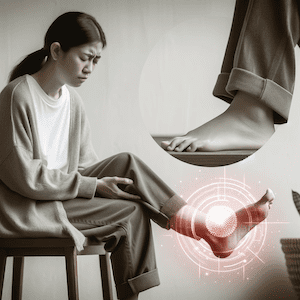Ice Skating Injuries
Article by John Miller

Ice Skating Injuries
Ice skating, blending balance, flexibility, and strength, captivates with its beauty and thrill. However, it’s not without ice skating injuries risks, ranging from bruises to more serious issues like concussions, fractures and ligament damage. These risks affect recreational and competitive skaters, particularly during complex movements like jumps and spins.
Common Injuries and Physiotherapy Solutions
Falls on the hard ice surface often cause bruises or more severe injuries such as wrist fractures or knee damage. Repetitive movements in skating can lead to overuse injuries in joints, particularly the knees and hips. These joint injuries may manifest as ligament sprains or cartilage damage, often requiring careful management.
Foot injuries, including Achilles tendinopathy and plantar fasciitis, are also prevalent due to the tight skating boots, which can restrict movement and place additional stress on the feet and ankles.

Physiotherapy’s Role in Recovery and Prevention
Recent research in physiotherapy underscores the effectiveness of targeted exercises and rehabilitation protocols for these injuries. Strengthening and stabilising exercises play a vital role in the recovery of knee and ankle injuries. Physiotherapists also recommend specific stretches and mobility exercises to prevent overuse injuries. These exercises not only alleviate current symptoms but also contribute to preventing future injuries.
In addition to these exercises, physiotherapists utilise hands-on techniques such as soft tissue massage and joint mobilisation to manage pain and enhance recovery. These techniques improve circulation, reduce muscle tension, and increase joint mobility, facilitating a quicker return to ice skating.
Enhancing Balance and Proprioception
Balance and proprioception exercises form another crucial aspect of rehabilitation. Skaters, due to their sport’s nature, require excellent balance and body awareness. These exercises help in restoring confidence and control, critical for performing on ice. Furthermore, physiotherapists often incorporate sport-specific drills into the rehabilitation process. These drills ensure that the skater’s return to the ice is safe and effective, reducing the risk of re-injury.
Educating Skaters for Long-term Health
Lastly, education about injury prevention and proper skating techniques is an integral part of physiotherapy. Skaters learn about the importance of correct foot positioning, body alignment, and movement patterns, which are essential in preventing injuries common in ice skating. By understanding the mechanics of their sport, skaters can improve their performance and reduce the likelihood of future injuries.
Physiotherapists play a pivotal role in not only treating the injuries but also in educating skaters on maintaining optimal physical health. This comprehensive approach ensures that skaters can enjoy their sport with reduced risk and enhanced performance.
Preventative Measures and Skating Safety
Essential Warm-up and Training Protocols
To prevent injuries, it’s vital to warm up and stretch before skating. A proper warm-up increases blood flow to the muscles, reducing the risk of strains and sprains. Dynamic stretching, in particular, prepares the body for the specific movements involved in skating. Proper training and readiness assessment for new skills are essential. This includes gradually building up to more complex techniques and ensuring that the basics are mastered first.
Appropriate Gear and Attire for Safety
Skaters should wear appropriate attire, including well-fitted skates that provide adequate support to the ankles and feet. This reduces the likelihood of falls and related injuries. Additionally, protective gear such as wrist guards, knee pads, and helmets should be worn, especially by beginners or those attempting advanced manoeuvers.
Importance of Rest and Professional Care
Avoiding skating when injured or exhausted is crucial, as fatigue can impair judgment and physical coordination, increasing the risk of accidents. Rest and recovery are as important as the activity itself in preventing overuse injuries.
Having a first aid kit on hand is essential for addressing minor injuries immediately. In case of pain or injury, seeking professional medical care promptly can prevent further damage. Early intervention by a healthcare professional ensures appropriate management and a quicker return to the ice.
Nutrition and Environmental Awareness
Hydration and nutrition also play a significant role in injury prevention. Staying hydrated helps maintain peak physical performance, while a balanced diet provides the necessary nutrients for muscle recovery and energy.
Lastly, understanding the environment is key. Skaters should be aware of their surroundings, including other skaters, to avoid collisions. They should also be cautious of ice conditions, avoiding skating on thin or uneven ice, which can lead to falls and injuries.
Conclusion
Ice skating, while beautiful, poses inherent risks. By understanding common injuries, adopting preventive measures, and consulting a physiotherapist when needed, skaters can minimise injury risks and enjoy long-term participation in the sport.
What to Do?
Experiencing discomfort or injury from ice skating? It’s important to seek professional advice. A physiotherapist can offer personalised exercises, rehabilitation plans, and preventive strategies to safeguard your wellbeing and enhance your skating performance.
Related Articles
- Manual Physiotherapy Techniques – Offers a look into various manual therapy techniques that can be beneficial for treating sports injuries.
- Warming Up Exercises – Highlights the importance of proper warm-up routines to prevent injuries in physical activities like ice skating.
- Tendinopathies Overview – A comprehensive guide on tendinopathies, which can be a concern for ice skaters due to repetitive movements.
- Acute and Sub-Acute Injury Management – Offers insights into managing both immediate and short-term injuries that might occur in ice skating.
- Exercise Prescription for Rehabilitation – Details on how physiotherapy exercises can aid in the recovery from sports injuries.
- Sports Injury Management – A broader look at managing various sports injuries, applicable to ice skating.
- Physiotherapy Treatment: Strategies for Healing and Mobility – An overview of different physiotherapy treatments available for sports-related injuries.
Rochedale - Call 38410277
Book Online: RochedaleSalisbury - Call 32751044
Book Online: SalisburySandgate - Call 32691122
Book Online: SandgateCommon Muscle Injuries
A Physiotherapist's Guide
Introduction
Muscle injuries, presenting as muscle strain, pain or myalgia, are prevalent health issues affecting a wide range of individuals. This detailed guide, from a physiotherapist's perspective, delves into various muscle injuries, elaborating on their management, prevention, and the importance of professional advice. Explore the linked articles for an in-depth understanding of muscle injuries and their effective treatment.
Neck & Back Muscle Injuries: Causes and Solutions
- Back Muscle Pain: This pain often results from prolonged poor posture or physical overuse. Key to relief is engaging in exercises that strengthen the core muscles and improve posture, thereby alleviating the strain on the back.
- Neck Sprain: Caused by sudden, awkward movements, a neck sprain can benefit from a combination of gentle stretches and targeted strengthening exercises to restore flexibility and strength.
- Text Neck: A modern ailment resulting from extended mobile device use, text neck can lead to chronic pain. Regular breaks, posture-awareness, and neck-strengthening exercises are essential for prevention.
- Whiplash: Commonly occurring in car accidents, whiplash requires a careful approach including neck stabilisation exercises and controlled movement to encourage healing and prevent further injury.
Lower Limb Muscle Injuries: Understanding and Treating
- Hamstring Strain: Particularly common among athletes, particularly runners, this strain demands rest initially, followed by a carefully structured rehabilitation program focusing on gradual strength building and flexibility.
- Thigh Strain: Often seen in sports involving sprinting and jumping, thigh strains need a combination of rest, ice, compression, and elevation (RICE) in the initial stages, followed by carefully planned strengthening exercises.
- Groin Strain: This injury requires a nuanced approach, including sufficient rest and targeted exercises, to ensure a safe and effective recovery.
- Calf Muscle Tear: Key to recovery is a balance of rest, gentle stretching exercises, and a gradual return to full activity, ensuring the muscle heals correctly and strength is regained.
Upper Limb Muscle Injuries: Prevention and Care
- Golfer's Elbow and Tennis Elbow: Both these conditions involve inflammation of the tendons and require a rest period, followed by ice therapy and specific exercises tailored to strengthen the affected muscles.
- Corked Thigh: Resulting from direct impacts, these injuries demand immediate application of ice and a controlled, gradual exercise regime for recovery.
- DOMS, Fatigue-Related Cramps & Myalgia: Adequate rest, good hydration, and gentle stretching are crucial in alleviating these conditions.
- RSI: Regular stretching, ergonomic workplace adjustments, and taking breaks are key preventive measures for repetitive strain injury.
Systemic Causes of Muscle Pain: A Holistic View
- Fibromyalgia: This complex condition demands a holistic treatment approach, including exercise routines, stress management techniques, and sometimes medication.
- Rheumatoid Arthritis: Effective management combines medication, gentle exercise, and regular physiotherapy sessions.
Prevention and Management Strategies
- Regular Exercise: Regular physical activity helps maintain muscle strength and flexibility, reducing the risk of muscle injuries.
- Posture Improvement: Good posture, both in motion and at rest, is crucial for preventing muscle strain.
- Proper Warm-up and Cool-down: Adequate warm-up before and cool-down after physical activity is vital in preventing muscle strains and injuries.
- Ergonomic Adjustments: Making ergonomic adjustments at work and during daily activities can significantly reduce the risk of repetitive strain injuries and other muscle-related issues.
- Maintaining a Healthy Weight: Keeping a healthy weight reduces the strain on muscles, particularly in weight-bearing joints.
What to Do? Seeking Professional Advice
Consult a physiotherapist or doctor for personalised advice and treatment plans. Remember, early intervention can significantly improve recovery outcomes and prevent chronic problems.
Conclusion
While muscle injuries are common, effective management and prevention are achievable with the right approach and knowledge. Understanding the causes, symptoms, and various treatments available empowers individuals to take proactive steps in their recovery and prevention. For the most tailored and effective treatment, always seek the guidance of a professional physiotherapist.
Rochedale - Call 38410277
Book Online: RochedaleSalisbury - Call 32751044
Book Online: SalisburySandgate - Call 32691122
Book Online: SandgateCommon Ligament Injuries


Ligament Injury
Ligament injuries frequently occur in various body parts, leading to pain and restricted movement. The most common sites include the knee, ankle, shoulder, wrist, hand, and spine.
Notably, knee injuries like ACL, PCL, MCL, and LCL sprains are prevalent.
Shoulder injuries often involve the AC joint, while wrist and hand issues can include thumb and finger sprains.
Spinal ligament injuries, such as back and neck sprains, and whiplash, are also significant. Understanding these injuries helps in prevention, early detection, and effective treatment.
- Ankle Ligament Injuries
- Knee Ligament Injuries
- Shoulder Ligament Injuries
- Wrist & Hand Ligament Injuries
- Spinal Ligament Injuries
Ankle Ligament Injuries
Ankle injuries often result from sudden twists or rolls, leading to sprains and strains.
Knee Ligament Injuries
Knee ligament injuries are among the most common and can severely impact mobility and quality of life.
- ACL Injury
- PCL Injury
- MCL Sprain
- LCL Sprain
- Posterolateral Corner Injury
- Patella Dislocation
- Superior Tibiofibular Joint Sprain
Shoulder Ligament Injuries
Shoulder ligament injuries can be debilitating, affecting a range of movements.
Wrist & Hand Ligament Injuries
Injuries in the wrist and hand are common, especially in sports and physical activities.
Spinal Ligament Injuries
Spinal ligament injuries can result from various causes, including posture issues and physical impacts.
Related Articles
- Ligament Tear - Common Ligament Injuries: Offers a comprehensive overview of ligament injuries across different body parts, including prevention, early detection, and effective treatment strategies.
- Knee Ligament Injury - A Physiotherapist's Guide & Tips: Provides insights into diagnosing knee pain, covering ligament issues among other concerns, and suggests pain relief methods through exercise and treatment.
- Common Ankle Ligament Injuries: A Physiotherapist's Guide: Discusses the treatment and prevention strategies for ankle ligament injuries, emphasising the importance of early intervention.
- Sprained Ankle Treatment & Recovery Guide: Offers detailed guidance on the recovery timelines for sprained ankles, highlighting the importance of restoring strength, motion, and function for a full recovery.
- Ankle Strapping: Complete Guide To Injury Prevention: Focuses on preventing ankle injuries through effective strapping techniques and discusses conditions like ankle arthritis and biomechanical issues.
- Sub-Acute Soft Tissue Injury: Explores the treatment and recovery process for various ligament injuries, including those affecting the knee, shoulder, wrist, hand, and spine.
- Sprained Thumb Treatment And Recovery Tips: Delivers practical tips for treating and recovering from a sprained thumb, along with general management strategies for wrist and hand pain.






































































